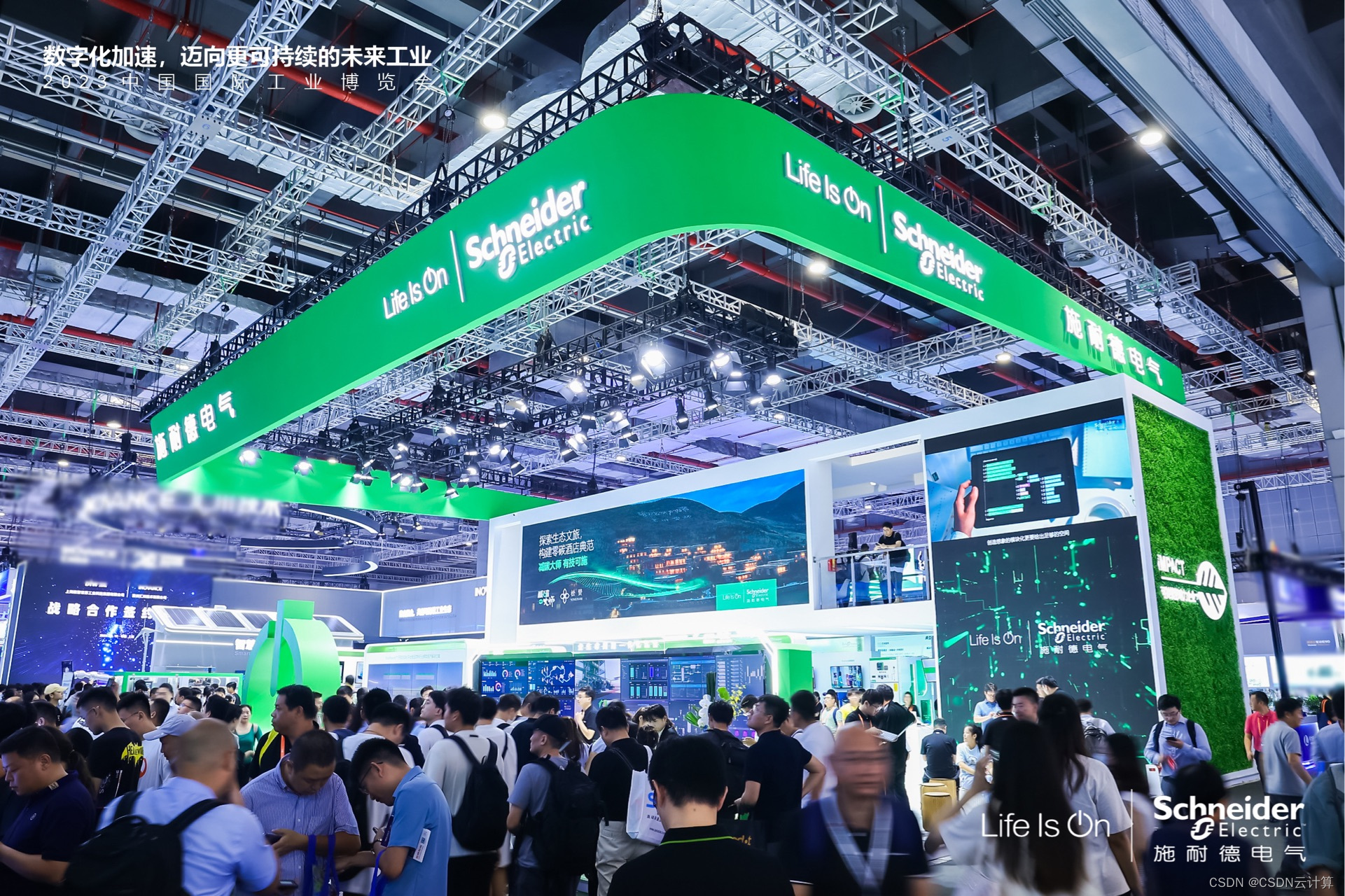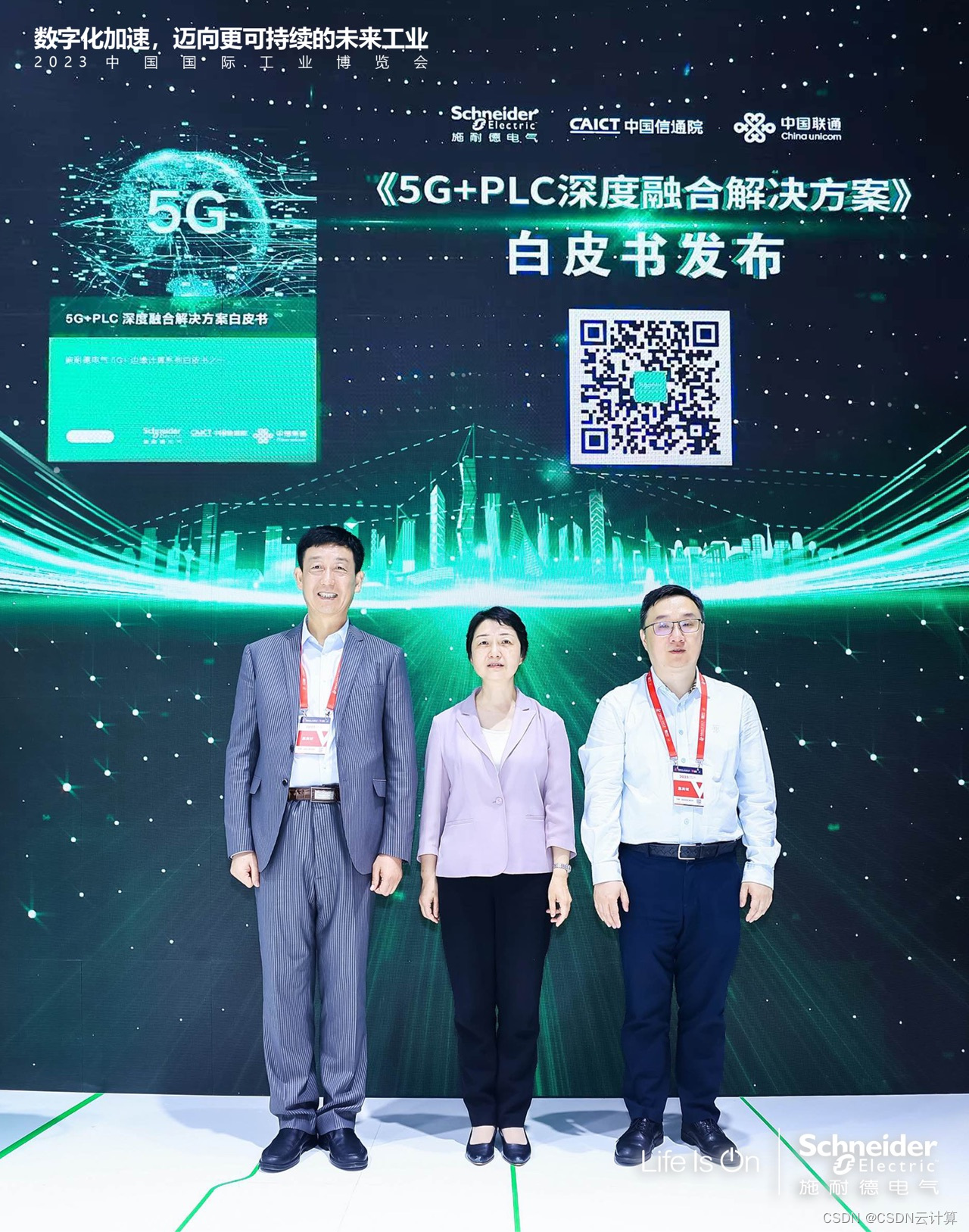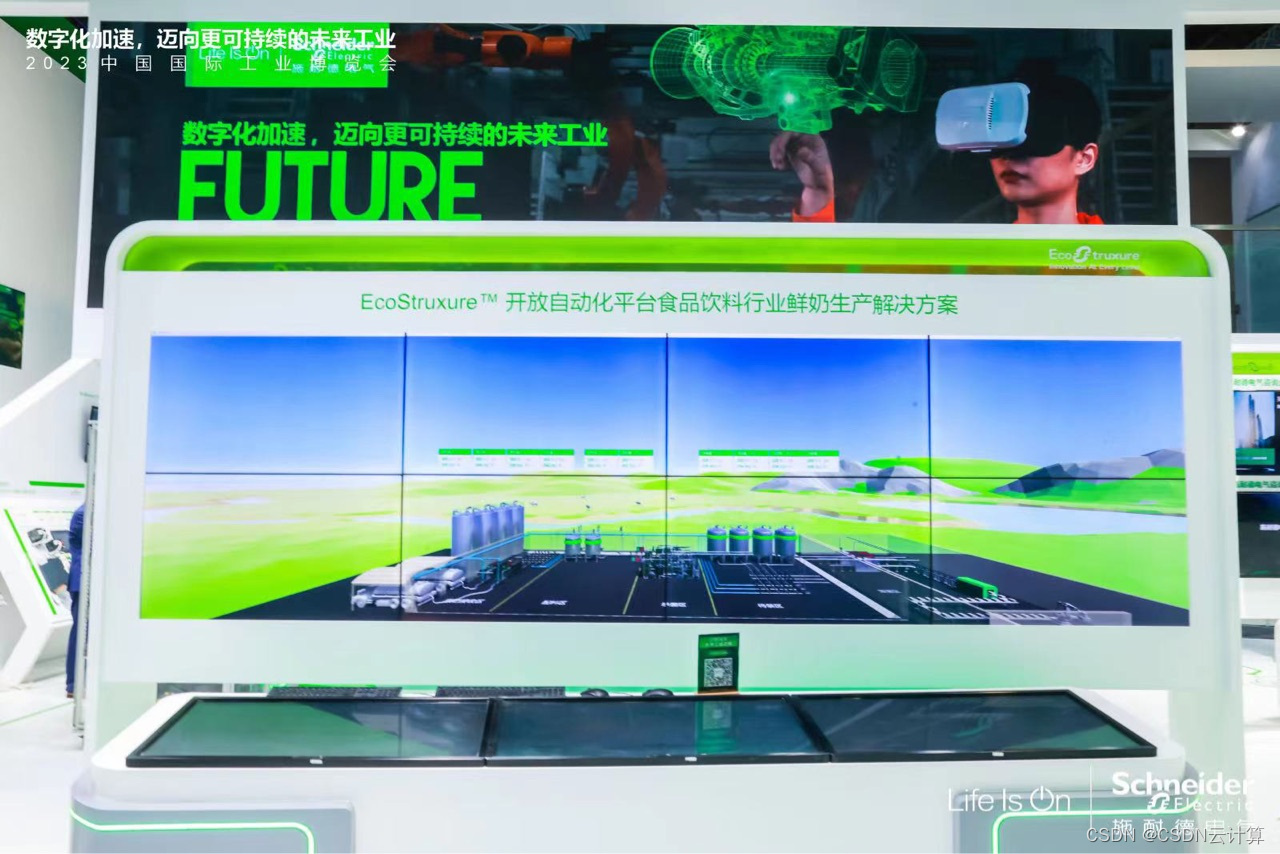
On September 19, the 23rd China International Industrial Fair (referred to as the "Industry Fair") was grandly held in Shanghai. As a global digital transformation expert in the field of energy management and automation, Schneider Electric fully demonstrated its new vision and profound insights into future industry at the CIIF, not only demonstrating its ability to integrate the entire life cycle of enterprise design, construction, operation and maintenance. Many of its cutting-edge technologies and innovative solutions also brought its latest achievements in open automation, the combination of 5G technology and PLC (Programmable Logic Controller, Programmable Logic Controller), providing participants with a platform to explore and understand the industry. The opportunities for future trends and development directions of the market highlight Schneider Electric’s firm commitment and positive actions in promoting Industry 4.0 and future industrial development.
Through these sharings, we can get a glimpse of the possible development direction of the future industry and how companies can respond to future market challenges and changes in consumer demand through technological innovation and continuous investment.
1. 5G+PLC integration promotes the innovation power of Industry 4.0
On the first day of the CIIF, Schneider Electric joined hands with the China Academy of Information and Communications Technology ("CAICT") and China United Network Communications Group Co., Ltd. ("China Unicom") to jointly release the "5G+PLC Deep Integration Solution" White Paper (hereinafter referred to as the "White Paper"). The white paper aims to promote the innovative integration and practical application of 5G+PLC in the field of industrial core control through a systematic and in-depth analysis of research ideas, cutting-edge technologies, industrial breakthroughs and practical applications, and provide information for the digital, networked and intelligent transformation of industry. Strong driving force, while laying the foundation for high-quality and sustainable development of the industry.

The combination of 5G technology and PLC has always been regarded as one of the key technologies to promote Industry 4.0, because it can meet the demand for high-speed, low-latency communication in the future industrial development process and realize the popularization of industrial automation and intelligent manufacturing. The integration of the two not only represents an innovative combination of communication and control technology, but also means that industrial automation and intelligent manufacturing will enter a new stage. Therefore, the integration of 5G and PLC technology has become a highlight of this industry expo.
The white paper provides detailed interpretation and guidance for the application and development of this new technology. First of all, the white paper explains in detail the basic principles and characteristics of the integration of 5G and PLC technology, and through practical application cases, demonstrates the huge advantages of this technology in improving production efficiency, reducing costs and optimizing resource utilization. At the same time, the white paper also provides an in-depth outlook on the future trends and challenges of 5G+PLC integrated applications, aiming to promote its continued development in the field of industrial core control.
While revealing the feasibility of the integration of 5G+PLC in communication mechanisms and control models, the white paper also provides practical suggestions and guidance for the practical application and optimization of 5G networks in industrial control systems. According to reports, Schneider Electric’s flexible assembly line uses 5G+PLC to achieve more modularity. The production line switching time is shortened from 7 days to 15 minutes, the floor space is reduced by 50%, and the production capacity is increased by 12%.
In addition, Yao Jian, deputy general manager of China Unicom Shanghai Branch and commander of the China Unicom Equipment Manufacturing Corps, emphasized that the application of 5G in industrial production has shown a transformation from "local single point" to "global production" and from "peripheral applications" "A new situation of innovative development towards the "core of production". 5G+PLC is an innovative upgrade of "5G+Industrial Internet" and a new exploration of the manufacturing model of future industrial enterprises.
"This white paper is a successful practice of deepening and expanding 5G technology from peripheral auxiliary links in production to core control links. It will promote the integration of end, edge and cloud with the development of open technology and become an important milestone in the process of industrial digitalization." Senior Vice President of Schneider Electric Pang Xingjian, President and Head of Industrial Automation Business China, said, “As an active practitioner of 5G industrial applications, Schneider Electric hopes to share successful experiences with more industrial companies, share the dividends brought by digital technology, and move towards the future industry together. .”
2. Embrace digital green transformation and embark on the road to future industrial development
When discussing the future of industry and technological development, Schneider Electric demonstrated its forward-looking insights and latest practical results in the industrial field from the dimensions of industrial digital transformation and sustainable development.
As an important engine for industrial development, digital transformation has always been the focus of Schneider Electric. Shen Hongfeng, director of strategy and business development for Schneider Electric Industrial Automation China, pointed out that digital transformation is not limited to underlying data mining and organization. More importantly, companies need to deeply understand and apply these data from the perspective of management and operations. He believes that there is currently a lack of comprehensive talents who have a deep understanding of both IT and OT technologies and master lean management techniques. Thanks to the large number of engineering college students graduating every year, the country has a huge engineer dividend, which provides a solution to the problem of talent. The shortage problem provides confidence.
In addition to its commitment to promoting digital transformation, Schneider Electric is also deeply exploring how to combine digital technology with supply chain management to achieve data-driven, efficient business processes and effective business decisions. Through the industrial Internet platform, Schneider Electric has broken down the data barriers between IT and OT, allowing data to be circulated and applied in various business processes, thereby achieving more precise and intelligent control.
For example, Schneider Electric's Wuxi Lighthouse Factory uses digital system solutions to optimize around pain points such as warehousing space and production flexibility, and achieves effective business improvement by tapping into digital value. This practice not only demonstrates Schneider Electric’s practical experience in digital transformation, but also provides valuable reference for other companies on how to carry out digital transformation.
On the other hand, for sustainable development, Schneider Electric remains highly focused on achieving dual carbon goals and utilizing green energy. Focusing on the unique needs and challenges of process and discrete industries in terms of sustainable development, Pang Xingjian emphasized that although these two industries are very different in nature, they both face common "dual carbon" requirements. Among them, due to the particularity of the production process, the process industry will place more emphasis on stability, long-term and high-quality; while the discrete industry is transforming from large-scale production to more flexible and customized production, which is also accompanied by changes in marketing models. Under the "dual carbon" vision, both companies should pay attention to the carbon emissions in their production processes, strictly track the carbon footprint of the product's entire life cycle, and take effective measures to manage energy.
In addition, when discussing topics related to the new energy field, Pang Xingjian said that in the face of the current environment and policy requirements, Schneider Electric will be committed to seeking new opportunities in the fields of new energy, new economy and new infrastructure, with a view to driving new growth Chance. Among them, Schneider Electric expressed its emphasis on green energy and green hydrogen industry, revealing its firm determination in sustainable development. In the past, the green hydrogen industry faced many obstacles on the production and consumer sides, including but not limited to the stability of power generation, requirements for smooth production energy consumption, long-distance transmission and green electricity, etc., which have restricted the development of the green hydrogen industry. Key factor. Now, through the promotion and development of projects such as green electricity to produce green hydrogen and green ammonia, new power systems are showing huge room for development. The new energy field, especially the green hydrogen industry, is regarded as the main subject and hot spot of future investment, and Schneider Electric is also actively planning in this field. Pang Xingjian pointed out that the green hydrogen industry is an important branch of the new energy field. As the technology continues to mature and relevant policies are vigorously promoted, the industry will usher in a golden period.
3. Focus on openness, from systems to innovation ecosystems to 5G+ industrial applications
As IT technology continues to penetrate the industrial field, the proprietary technology and software tool barriers created by the strong binding of existing automation software and hardware have become "shackles" for the future integration of industrial OT and IT. In Pang Xingjian’s view, only through open automation systems, open innovation ecosystems, and open 5G+ industrial applications can we truly help enterprises comprehensively improve efficiency, resilience, productivity, agility, and sustainability.
At the CIIF, Schneider Electric demonstrated its EcoStruxure open automation platform V23.0 version to be released in 2023. The platform has been expanded into an open platform integrating discrete, hybrid and process industry operations, with an integrated development environment based on IEC 61499 for the design, deployment and management of industrial control systems. Its open "plug and play" approach to automation software components has become a force for disruptive change in the industrial market, helping companies reduce investment costs and shorten R&D cycles, improve asset utilization, and respond quickly and flexibly. Market changes, more effective energy management and optimization, improved production efficiency and cost savings, thereby laying a solid foundation for achieving flexibility and sustainable development in the industrial field.

Only with an open mind and open ecology can enterprises go deeper and further on the road to industrial automation. In order to better promote the process of open automation, the non-profit international open automation organization UAO (UniversalAutomation.org) was established in 2021. Among them, EcoStruxure open automation platform is the first open automation system based on UAO shared runtime launched by members of the organization. Pang Xingjian said that as one of the first industry pioneers to join the Open Automation Organization UAO, Schneider Electric is working with the UAO organization to promote standards, openness, and universal concepts to help members of the organization innovate and create interoperable solutions. thereby enabling sustainable and lasting positive change in the industry.
As the core link of industrial production, the role of industrial control also occupies an increasingly important position in the context of industrial digital transformation. By actively promoting the integration and innovation of 5G+industrial Internet, Schneider Electric has taken the lead in realizing the successful application of "5G+PLC" in the discrete manufacturing industry. Pang Xingjian said: "Today, we are no longer limited to the hardware level. The next step for Schneider Electric to expand is 5G+ open automation. We hope that future engineers and users will not have to think about how to develop automation products, but focus on What functions can be achieved and how can we create greater value?”
4. In an uncertain environment, enterprises should comprehensively improve efficiency and resilience
"The closer we get to a period of stable development, the more structural adjustments we need to make." At a time when investment is becoming more cautious, Pang Xingjian feels the concerns of enterprises and is keenly aware of the changes in their internal drivers. He believes that in the era of globalization, companies emphasize efficiency, but affected by economic uncertainty, companies now have to pay more attention to the stability and resilience of the supply chain, which prompts them to start rethinking and planning. Nowadays, "fighting for speed" may not be the best production method. Only by analyzing all aspects of the enterprise using lean methodology can we see where waste can be reduced and efficiency improved.
The domestic manufacturing system is huge. In the process of industrial transformation and upgrading, shifting gears to speed up, improving quality and efficiency, and implementing carbon reduction, a large number of market opportunities will be created. Therefore, enterprises need to use lean methodology to cross the cycle and better survive. down and consider future developments. Pang Xingjian proposed that Schneider Electric has continued to make efforts in terms of capabilities and business layout in the past few years. It already has a data base and capabilities based on operational information management, and can provide customers with more digital twin solutions to avoid delays in its construction phase. Extensive planning and investment philosophy. Whether it is the user's current transformation or a new project in the future, by planning earlier, future IT needs can be more deeply integrated into the OT link. This is a goal that current industrial enterprises need to work together with enablers to achieve .
Schneider Electric will continue to deeply explore the Chinese market, strive to explore market potential, and support the sustainable development and transformation and upgrading of various industries in the Industry 4.0 era by continuously strengthening research and development and investment in related fields. From a global perspective, Schneider Electric will continue to maintain an open and learning attitude, pay close attention to global market dynamics and technology development trends, and contribute to the sustainable development of enterprises, markets and society.
Driven by high-quality development and "dual carbon" goals, the digitalization and green and low-carbon transformation of China's industry is accelerating. However, the dual transformation of digitalization and sustainable development is not the end of industrial development, but the beginning of a new journey. By participating in this exhibition, Schneider Electric aims to let more industrial companies understand Schneider Electric's digital technology expertise and sustainable development experience through the platform of the CIIF, and looks forward to joining hands with more industrial partners to accelerate the move towards a more open and open world. Efficient and resilient, sustainable, people-centered future industry.